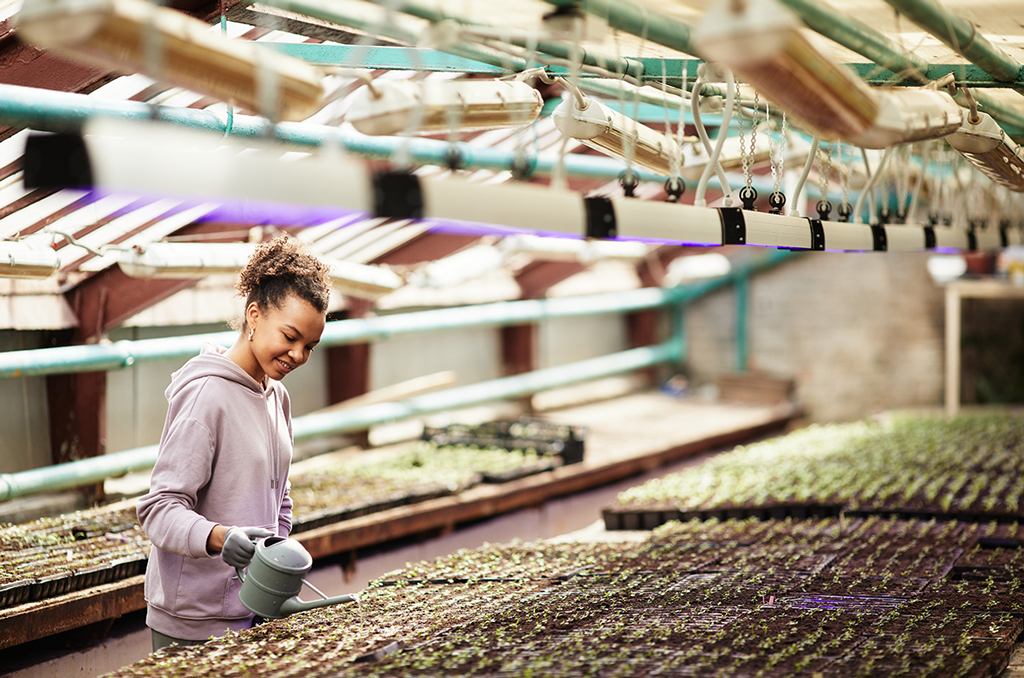
The Farms Sprouting Underneath Our Cities
- foodfightadmin
- October 13, 2023
- Agriculture, Climate Change, Global Hunger
- rsc pages, rscl
- 0 Comments
By growing and selling food closer to consumers, we can significantly shorten the supply chain
Colder climes like the US, Northern Europe, and Canada heavily rely on imports for fresh fruits and vegetables during winter and spring to meet consumers’ year round demands for these products.
The concept of farming nearer to consumers makes sense but efficient large scale farming requires space, and a vast amount of it. Industrial Agriculture, assisted by mechanization, has led to cheaper food costs for consumers while ensuring widespread availability. But large farms require substantial machinery and long, straight paths for operation, which are not available in densely populated areas.
Recognizing this hurdle, some visionaries are exploring alternate methods of feeding the urban populace. In Paris, for instance, Jean-Noel Gertz, CEO of Cycloponics, has identified 600 hectares of unused parking space as a potential farming plot. His vision is to convert these to underground farms to cultivate organic mushrooms and endives, which can easily be grown indoors.
While these crops alone will not consume all the underground space, Gertz envisions it being utilized as a hub for local food startups. By equipping these locations with logistics and cold rooms, entrepreneurs can use these spaces as a launchpad to feed city dwellers.
In parallel, numerous high tech, climate controlled indoor farms have started sprouting across the globe. These are furthering the novel concept of urban agriculture by remodeling shipping containers into mini farming plots, each sporting its own adjustable environmental parameters.
At Square Roots, a company based in Brooklyn, climate effective cultivation is a reality. They replicate the climate of source regions for their crops by studying local parameters like humidity, light, heat, and soil nutrients. Square Roots has swiftly expanded the variety of crops they produce, from herbs and leafy greens to heavier produce such as tomatoes, strawberries, and even habaneros. On the environmental side, Square Roots closely monitors their carbon footprint and works to reduce it’s impact through design, energy, and distribution.
In the US, the availability of space certainly isn’t an issue. With an estimated two billion parking spaces and abandoned malls, there’s plenty of room to host these container farms. Given local authorities already have established protocols for handling shipping containers, repurposing them as miniature farms is relatively uncomplicated.
In addition to sustainable farming, these containers leverage AI to communicate with each other, maintaining an updating feedback loop for evolving conditions. They sidestep long transportation routes and instead use a fleet of battery-powered trikes equipped with cold storage units for delivery, ensuring the produce reaches consumers within hours, not weeks.
Meanwhile, in London, Steve Dring, the co-founder of Growing Underground, is tapping into the productive potential of disused World War Two air raid shelters. This venture, spanning 70,000 square feet of underground tunnels, stands as a testament to the possibility of space-efficient agriculture, even in densely populated urban areas.
All of these initiatives point us to a tantalizing prospect: capitalizing on unused urban estates to create a more efficient, sustainable food production system that brings the farm to the doorstep of the urban consumer.
If you first saw their set-up, you might mistake it for a scene pulled out of the popular TV series “Breaking Bad,” suggests Dring. In the depths of an urban labyrinth, crops bathe under a hypnotic pink light, a result of combining red and blue wavelengths optimal for plant growth. Making the most of available space, rows of plants line a DIY polytunnel on a mezzanine floor, with water and filtration systems on the premises below. The system in use is a specific type of hydroponics known as ebb and flow – it pushes water to the crops before allowing it to recirculate through a filter.
Much like Paris’s trove of subterranean car parks, this converted wartime bunker offers conditions conducive to controlled growth. “Regardless of whether it is -5°C or 30°C topside, the temperature in the tunnel, situated 110-120ft underneath London, stays a steady 14°C,” Dring points out.
Dring feels that what he and like-minded farmers are accomplishing needs to be more accurately labeled. Even though the technology utilized is similar to vertical farming, he prefers the designation “controlled environment agriculture.” “We exert control over the environment to an almost forensic level. If the goal is to regulate humidity and heat, starting from a constant 14°C baseline simplifies the process,” Dring explains.
Concerning tunnel farming, Dring acknowledges that one of the primary problems is ensuring sufficient airflow to prevent the accumulation of harmful pathogens. Fortunately, these air raid shelters built to house up to 8,000 individuals have “robust ventilation systems” already installed.
Novel urban locations for growth are being recognized as an opportunity, especially as supply chains face increasing strain. The situation is akin to “leaping 10 years into the future”, Gertz suggests. As this seismic shift in perceptions around food origin and content continues, we might soon be devoting more attention to understanding the paths our food takes from farm to plate.








